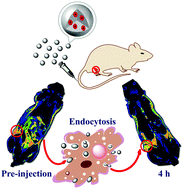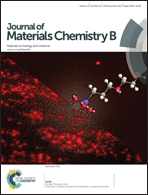Formation of iron oxide nanoparticle-loaded γ-polyglutamic acid nanogels for MR imaging of tumors†
Abstract
We report a facile approach to form iron oxide nanoparticle (NP)-loaded γ-polyglutamic acid (γ-PGA) nanogels (NGs) for MR imaging of tumors. In this study, γ-PGA with carboxyl groups activated by 1-ethyl-3-[3-dimethylaminopropyl]carbodiimide hydrochloride (EDC) in aqueous solution was firstly emulsified, followed by in situ chemical crosslinking with polyethyleneimine (PEI)-coated iron oxide NPs (PEI–Fe3O4 NPs) with a core size of 8.9 ± 2.1 nm synthesized via a mild reduction route. The formed γ-PGA NGs containing iron oxide NPs (γ-PGA/PEI–Fe3O4 NGs) with a size of 152.3 ± 13.1 nm are water-dispersible, colloidally stable, noncytotoxic in a given concentration range, and display a r2 relaxivity of 171.1 mM−1 s−1. Likewise, the hybrid NGs can be taken up by cancer cells with the uptake of Fe significantly higher than single Fe3O4 NPs. These properties render the formed γ-PGA/PEI–Fe3O4 NGs with an ability to be used as an effective contrast agent for MR imaging of cancer cells in vitro and the xenografted tumor model in vivo via the passive enhanced permeability and retention effect after intravenous injection. The developed γ-PGA/PEI–Fe3O4 hybrid NGs may hold great promise to be used as a novel contrast agent for MR imaging or other theranostic applications.


 Please wait while we load your content...
Please wait while we load your content...